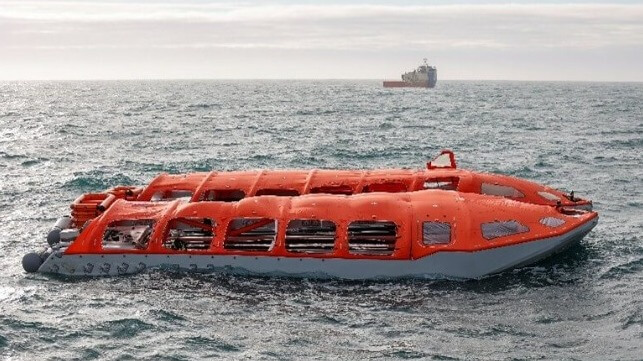Largest Inflatable Lifeboat Design Completes Key Tests

The world’s largest inflatable lifeboat has completed physical tests required for classification. Developed by Survitec, Seahaven is being presented as a new alternative to help cruise lines manage their increasing passenger capacities while also freeing up valuable deck space. It is the latest in several proposed designs that would help the cruise industry as it moves into and past passenger capacities of 6,000 or more people on the latest mega-ships.
“With Seahaven, we have taken all the safety features, testing, and type approval processes associated with lifeboats and MES to solve the challenge of being able to evacuate growing numbers of passengers quickly, safely, and comfortably,” said Richard McCormick, Survitec Product Manager AES and MES. He describes Seahaven as “providing a totally different outlook on evacuation at sea.”
The design is for a 1,060-capacity inflatable lifeboat solution for cruise vessels, Survitec reports that the lifeboat recently completed the International Maritime Organization A.520 physical tests as required by classification society Lloyd’s Register. The stringent tests included ship sinking scenarios and a timed evacuation, which was achieved in less than 22 minutes. Under the International Convention for the Safety of Life at Sea (SOLAS) rules, evacuation should not exceed 30 minutes.
Seahaven launches with the push of a button and automatically inflates, taking just four minutes to deploy. It employs a slide-based Survival Technology solution to improve passenger evacuation time without compromising on safety. Once deployed, the inflatable lifeboat can travel independently for 24 hours at a speed of six knots.
Using the inflatable design, Seahaven requires less space than conventional lifeboats or tenders currently deployed on most cruise ships and has a larger capacity than the currently used inflatables. According to the company, it will reduce the amount of deck space required for evacuation systems by up to 85 percent.
“Seahaven is unusual in that it is the first lifeboat to have been through, and continues to go through, an exhaustive reliability testing program that far exceeds the testing requirements set out by SOLAS,” says Survitec. During the A.520 tests, conditions were created similar to those that seafarers and passengers would encounter in a real-life evacuation.
The A.520 tests followed the December 2021 Heavy Weather Sea Trials, carried out in line with SOLAS requirements for Novel Appliances. Those trials saw Seahaven deployed from EDT Jane, an 80-meter offshore support vessel, with representatives from Class and observers from UK MCA in attendance.
Survitec began developing the solution following its early involvement with the EU-led and -funded Safedor project, which worked with classification societies, operators, and flag states to integrate safety as a design objective into ship design and risk assessment into approval frameworks. The recent tests and sea trials represent the culmination of this process for the company.
